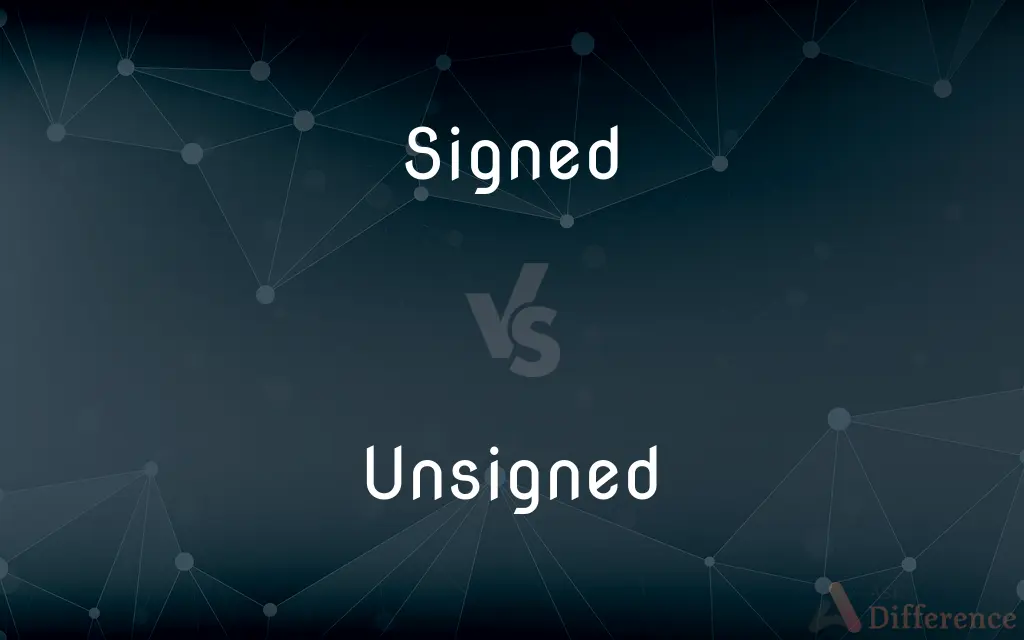Signed vs. Unsigned — What's the Difference?
Edited by Tayyaba Rehman — By Urooj Arif — Updated on April 21, 2024
Signed numbers include both positive and negative values, whereas unsigned numbers are always non-negative, representing a range from 0 upward.

Difference Between Signed and Unsigned
Table of Contents
ADVERTISEMENT
Key Differences
Signed numbers can represent both positive and negative integers, using a sign bit to indicate the sign. Whereas, unsigned numbers only represent non-negative integers, typically allowing for a larger range of positive values than signed numbers of the same bit size.
The use of signed numbers is essential in scenarios where calculations might involve negative results, such as in financial accounting or temperature variations. On the other hand, unsigned numbers are often used in contexts where only non-negative values make sense, such as counting objects or indexing arrays.
In binary coding, signed numbers utilize one bit (most commonly the highest-value bit) to represent the sign, reducing the magnitude range they can represent by half. In contrast, unsigned numbers use all available bits for magnitude, providing a wider range of positive numbers.
When programming, choosing between signed and unsigned types can affect the behavior of arithmetic operations and comparisons. For example, overflow behaviors differ significantly: with signed integers, an overflow might produce a negative number, whereas, with unsigned integers, the count wraps around to zero.
Error handling is also different due to the nature of signed and unsigned numbers. Misuse of unsigned numbers can lead to errors going unnoticed, such as subtracting in a way that unexpectedly wraps around. Signed numbers provide more predictable error behaviors in negative value contexts.
ADVERTISEMENT
Comparison Chart
Value Range
Negative and positive numbers
Only non-negative numbers
Bit Usage
One bit for sign
All bits for value magnitude
Typical Usage
Balances, temperatures
Object counts, array indexes
Overflow Behavior
Can become negative
Wraps around to zero
Error Handling
Predictable with negatives
Errors can go unnoticed
Compare with Definitions
Signed
Prone to more complex error handling.
Signed overflow might need specific checks in software.
Unsigned
Suitable for scenarios where negatives are illogical.
The number of users on a platform is an unsigned count.
Signed
Capable of holding both positive and negative values.
A signed integer in programming might range from -128 to 127.
Unsigned
Wraps around to zero on overflow.
Adding 1 to an unsigned maximum loops it back to zero.
Signed
Requires a sign bit to indicate positivity or negativity.
In a signed byte, the most significant bit is used as the sign bit.
Unsigned
Less complex in error scenarios where negatives aren’t a factor.
Unsigned types simplify error checking in certain applications.
Signed
Used where arithmetic operations might cross zero.
Calculating net earnings can require signed numbers.
Unsigned
Only capable of representing non-negative values.
An unsigned integer can store values from 0 to 255.
Signed
Can experience overflow to negative values.
Adding 1 to the maximum signed value results in the minimum negative value.
Unsigned
Uses all available bits for the magnitude of the number.
In an unsigned byte, all 8 bits contribute to the value's size.
Signed
Having a signature affixed
A signed document.
Unsigned
(computing) Not accepting negative numbers; having only a positive absolute value.
We use an unsigned variable to store the employee's salary, since it will never be less than zero.
Signed
Of, relating to, or expressed in a sign language
A signed translation.
Unsigned
Lacking a signature, unendorsed.
The bank rejected the unsigned check.
Signed
Having a signature; endorsed.
The signed check could be cashed.
Unsigned
Not signed to an organization such as a sports club or record label.
Signed
Having both positive and negative varieties.
It wasn't until they tried to subtract 3 from 1 that the elementary school students realized they needed signed numbers.
Unsigned
(computing) A numeric value or variable that has no sign and can only be positive.
Signed
(of a road, route) Furnished with signs and signposts; signposted.
Unsigned
Lacking a signature;
The message was typewritten and unsigned
Signed
Simple past tense and past participle of sign
Signed
Having a handwritten signature;
A signed letter
Signed
Used of the language of the deaf
Common Curiosities
What is the main difference between signed and unsigned numbers?
Signed numbers can be negative or positive, while unsigned numbers are always positive.
Where are signed numbers typically used?
In scenarios requiring representation of both gains and losses, like financial balances or temperatures.
How does the sign bit work in signed numbers?
It determines whether the number is positive or negative, with one standard bit pattern reserved for each.
Are unsigned numbers safer to use than signed numbers?
Not necessarily; they simplify certain operations but can introduce errors if negative conditions are not considered.
Why choose unsigned numbers in programming?
For tasks where only non-negative values make sense, such as counting objects or indexing data structures.
What happens when an unsigned number overflows?
It wraps around to zero, which can lead to unexpected results if not handled properly.
What is an example of a signed number in use?
Measuring temperature in degrees Celsius, which can be above or below zero.
What is an example of an unsigned number in use?
Counting the number of students in a classroom.
Can signed numbers be used in all programming languages?
Yes, most programming languages support both signed and unsigned types, though their default behaviors may vary.
How does one convert a signed number to unsigned in programming?
This involves interpreting the same bit pattern as a positive number, which can change its perceived value.
Share Your Discovery

Previous Comparison
Wisdom vs. Wit
Next Comparison
HTTP vs. FTPAuthor Spotlight
Written by
Urooj ArifUrooj is a skilled content writer at Ask Difference, known for her exceptional ability to simplify complex topics into engaging and informative content. With a passion for research and a flair for clear, concise writing, she consistently delivers articles that resonate with our diverse audience.
Edited by
Tayyaba RehmanTayyaba Rehman is a distinguished writer, currently serving as a primary contributor to askdifference.com. As a researcher in semantics and etymology, Tayyaba's passion for the complexity of languages and their distinctions has found a perfect home on the platform. Tayyaba delves into the intricacies of language, distinguishing between commonly confused words and phrases, thereby providing clarity for readers worldwide.
















































